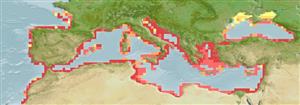Environment: milieu / climate zone / depth range / distribution range
বাস্তুসংস্থান
সামুদ্রিক; ঈষৎ লোনা তলদেশ বিহারী; গভীরতার পরিসীমা 10 - ? m (Ref. 3573). Subtropical; 47°N - 29°N, 11°W - 42°E
Eastern Atlantic: Mediterranean Sea, the Black Sea, Sea of Azov and Atlantic coasts from Morocco to France. Introduced to Iran and is now naturally occurring in the Caspian Sea basin (Ref. 50218).
Length at first maturity / আকৃতি / ওজন / Age
Maturity: Lm 21.3, range 17 - 22 cm
Max length : 40.0 cm SL পুরুষ/ লিঙ্গ অনিধর্ারিত ; (Ref. 3397); common length : 30.0 cm TL পুরুষ/ লিঙ্গ অনিধর্ারিত ; (Ref. 9987)
Adults usually in schools inhabit coastal waters (Ref. 3573); sometimes in lagoons and estuaries (Ref. 59043). Juveniles around 2.0 cm SL move to coastal lagoons and estuaries in summer and autumn (Ref. 59043). Adults are herbivorous feeding on algae and vegetal detritus while juveniles feed on zooplankton until about 3 cm SL, then on benthic organisms until 5 cm SL (Ref. 9987, 59043). Reproduce in summer (Ref. 2804). Oviparous, eggs are pelagic and non-adhesive (Ref. 205). Utilized for roe, but also fresh, smoked and frozen (Ref. 9987).
Thomson, J.M., 1986. Mugilidae. p. 344-349. In J. Daget, J.-P. Gosse and D.F.E. Thys van den Audenaerde (eds.) Check-list of the freshwater fishes of Africa (CLOFFA). ISNB, Brussels, MRAC; Tervuren; and ORSTOM, Paris. Vol. 2. (Ref. 3573)
IUCN Red List Status (Ref. 130435: Version 2024-1)
Threat to humans
Harmless
Human uses
মৎস্য: গৌণ বাণিজ্যিক ; এ্যাকুয়াকালচার (জলজ পালন) : বাণিজ্যিক
হাতিয়ার
Special reports
Download XML
ইন্টারনেট সুত্র
Estimates based on models
Preferred temperature (Ref.
123201): 14.4 - 21.5, mean 18.4 °C (based on 154 cells).
Phylogenetic diversity index (Ref.
82804): PD
50 = 0.5005 [Uniqueness, from 0.5 = low to 2.0 = high].
Bayesian length-weight: a=0.01072 (0.00898 - 0.01278), b=2.96 (2.93 - 2.99), in cm total length, based on LWR estimates for this species (Ref.
93245).
ট্রফিক পর্যায়ে (Ref.
69278): 2.9 ±0.38 se; based on food items.
Generation time: 4.2 (3.4 - 5.5) years. Estimated as median ln(3)/K based on 12
growth studies.
স্থিতিস্থাপক (Ref.
120179): মাধ্যম , সর্বনিম্ন প্রজন দ্বিগুনের সময় ১.৪-৪.৪ বৎসর (K=0.2-0.3; tm=3-4).
Fishing Vulnerability (Ref.
59153): Moderate to high vulnerability (45 of 100).
Climate Vulnerability (Ref.
125649): Moderate vulnerability (39 of 100).
Nutrients (Ref.
124155): Calcium = 51.7 [14.1, 292.9] mg/100g; Iron = 0.722 [0.360, 1.278] mg/100g; Protein = 18.4 [17.0, 20.0] %; Omega3 = 0.73 [0.33, 1.67] g/100g; Selenium = 6.96 [2.86, 17.33] μg/100g; VitaminA = 12.3 [3.7, 38.5] μg/100g; Zinc = 0.621 [0.386, 0.987] mg/100g (wet weight); based on
nutrient studies.
